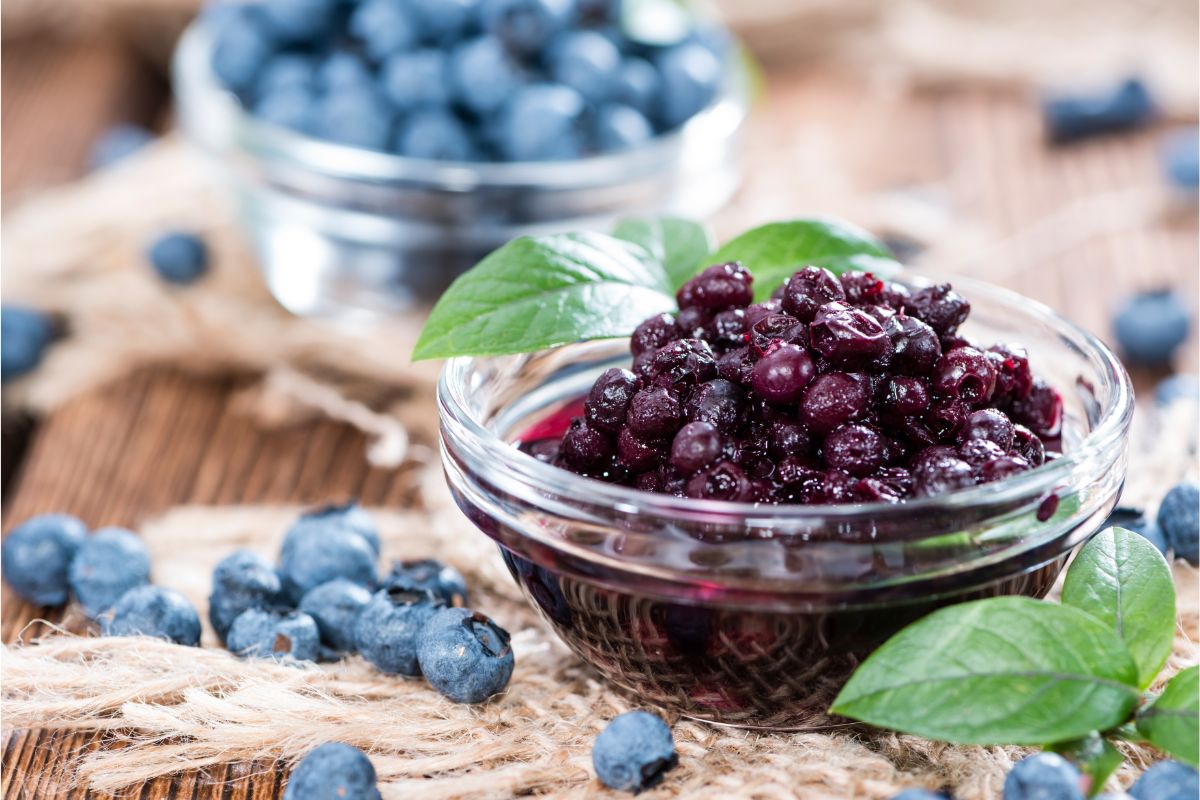When canning blueberries, wash the blueberries, rinse, drain, and remove stems. Blanch in boiling water for 30 seconds, pack into hot canning jars, leaving ½ inch headspace. Process in a boiling water canner for 15-25 minutes or 8-10 minutes if using a pressure canner.
Should Blueberries Be Pressure Canned or Water Bath Canned?
Water bath canning is the preferred method of processing blueberries. According to the National Center for Home Food Preservation, high-acid foods, including fruits, have sufficient acidity to prevent the growth of botulism spores when heated in a water bath. Pressure canning may cause the blueberries to lose structural integrity and become mushy due to the higher processing temperature.
Print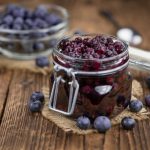
Canning Recipe for Blueberries
- Total Time: 30 minutes
- Yield: 7 quarts 1x
Description
Is it your first time caning blueberries? This canning recipe features easy-to-follow, step-by-step directions that will help make canning blueberries a breeze for beginners and seasoned canners alike!
Ingredients
- 12lbs fresh blueberries
- 1 ¼ cups sugar
- Water
Instructions
- Wash all canning equipment, including jars, lids, and screw bands. Simmer jars in boiling water until ready to fill. Warm lids at 180°F in steaming water or per the manufacturer’s instructions.
- Fill your boiling water canner with water halfway, add the canning rack, and set it on a stove to heat.
- Sort your blueberries. Choose only fresh, fully-ripe, uniformly-colored, firm-skinned berries.
- Wash your fruits in batches under cool running water. Drain thoroughly in a colander or large sieve. Remove and discard leaves and stems.
- For the hot pack method, bring water to a boil in a clean stock pot. Allow the berries to blanch for 30 seconds.
- Drain the fruits in a colander. Ladle the hot blueberries into hot jars, leaving ½ inch of headspace. Pour the hot blanching liquid over your fruits, maintaining the same headspace.
- De-bubble each jar using a bubble popper or non-metallic utensil. Wipe the jar rims clean with a damp cloth, then seal with lids and rings until fingertip tight.
- Load the filled jars carefully into your water bath canner. Adjust the water to ensure it is 1-2 inches above the top of the jar lids.
- Wait for the water to reach a rolling boil, then start the processing time. Process your pint and quart jars for 15-25 minutes, adjusting the time per altitude:
Water Bath Canning Processing
- 0 – 1,000ft: 15 minutes
- 1,001 – 6,000ft: 20 minutes
- 6,001ft and up: 25 minutes
Post Processing
- Once the processing time lapses, turn off the heat. Open the lid and leave the jars in the hot water for 5 minutes.
- Using a jar lifter, remove the jars, placing them on a towel-lined countertop. Allow them to cool for 12-24 hours undisturbed.
- Check the seal on each lid. Press each lid with your finger. Unsealed jars with lids that flex up and down should be refrigerated and used within 3-5 days. Sealed jars have firm seals that do not move.
- Remove the screw bands on the sealed jars. Wash them, and label them with the canning date and contents before storing them in a cool, dark, dry place.
- Prep Time: 10 minutes
- Canning Time: 15 minutes
- Cook Time: 5 minutes
Nutrition
- Serving Size: 1 cup
- Calories: 84kcal
- Sugar: 15g
- Sodium: 1.5mg
- Fat: 0.5g
- Saturated Fat: 0g
- Carbohydrates: 21g
- Fiber: 3.6g
- Protein: 1.1g
- Cholesterol: 0mg
How to Can Blueberry Jam
Follow these steps to make delicious canned blueberry jam without pectin.
- Wash your canning jars, lids, and rings in warm, soapy water. Set lids aside to air-dry. Cover jars in boiling water as you prepare other ingredients.
- Fill your water bath canner halfway with water. Place a canning jar rack and heat on a burner.
- Wash 9 cups of fresh blueberries in cool, running tap water. Remove stems or leaves, rinse well, and drain thoroughly.
- Put the drained berries in a large pot and mash using a metallic potato masher.
- Set the pot on a stove under medium heat for berries to release juice, add 6 cups sugar, and bring the berry-sugar mixture to a boil.
- Stir frequently to ensure the sugar dissolves.
- Adjust the heat to high and cook your berries rapidly for 20 minutes or until the jam starts to gel.
- Reduce heat and cook the jam until it forms a soft, thick, spreadable mixture. Keep stirring to prevent scorching.
- Turn off the heat, and remove your pot from the burner. Skim the top, foamy layer off with a spoon, and discard.
- Using a canning funnel, ladle the hot blueberry jam into hot canning jars, leaving ¼ inch headspace.
- Wipe the jar rims with a damp paper towel. Apply new canning lids and screw bands to the jars, adjusting them until they are finger-tight.
- Load the jars into the water bath canner and set them on the canning rack. Ensure the water level is 1-2 inches above the tops of the jars.
- Bring the water to a rapid boil and cover the canner with its lid.
- Process the jars in a water bath for 5-15 minutes, adjusting per altitude:
Recommended time for the blueberry jam in a boiling water canner.
| Altitude (ft) | 0 – 1,000 | 1,001 – 6,000 | 6,001 + |
| Half-pints | 5 minutes | 10 minutes | 15 minutes |
| Pints | 5 minutes | 10 minutes | 15 minutes |
- Once the processing time is complete, turn off your stove, uncover the canner, and let the jars sit in the hot water for five more minutes.
- Remove the jars from the water using canning tongs. Place them on a wire rack or towel-covered surface to cool for 12-24 hours.
- Once cooled, test the seals by hitting the lids with a metallic spoon. Unsealed jars produce a low, dull sound. You may also press the center of each lid to see if the lids flex. Properly sealed jars will have stationary lids. Refrigerate and use unsealed jars within five days or reprocess immediately with new lids.
- Remove the screw bands from sealed jars and label them with the contents and canning date. Store the sealed jars in a cool, dry, clean place for up to 18 months.
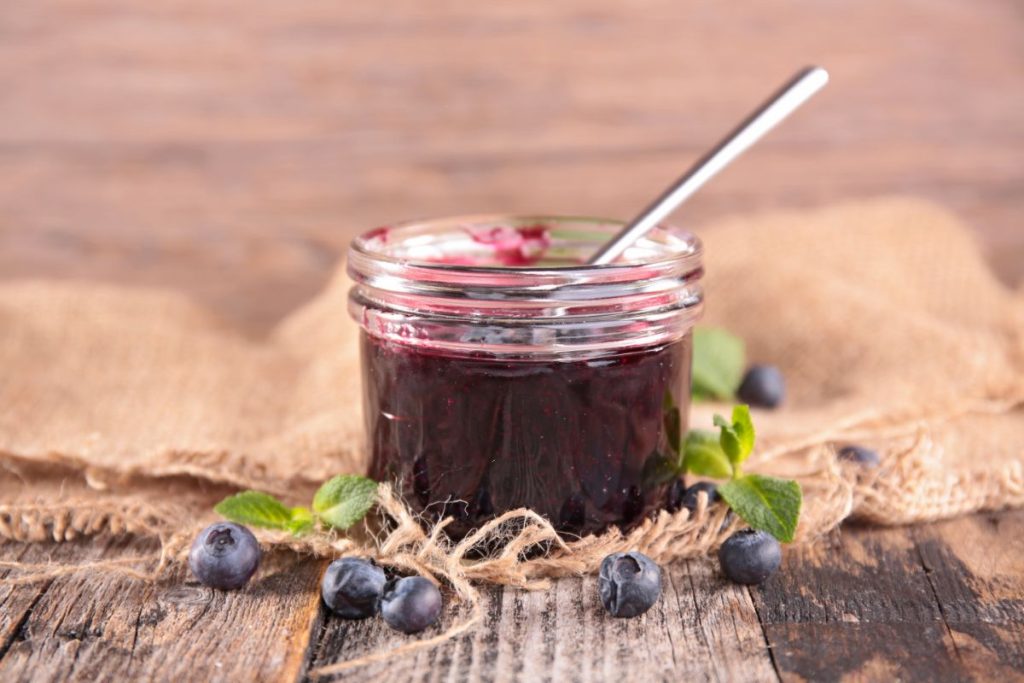
Is It Better to Can Fresh or Frozen Blueberries?
It’s better to can fresh blueberries. Fresh berries are plump, firm and produce a better quality canned product. Frozen blueberries have the same nutrition as fresh but with a softer texture and can only be cold-packed as hot packing may make them mushy.
Blueberry Canning: Raw Pack vs. Hot Pack
A raw pack involves packing clean fruits directly into jars without pre-heating or cooking them. Conversely, hot packs require food warming or pre-cooking before filling them into canning jars. Despite cold packing being faster, hot-packing blueberries prevent floating in the jars and preserves color during long-term storage.
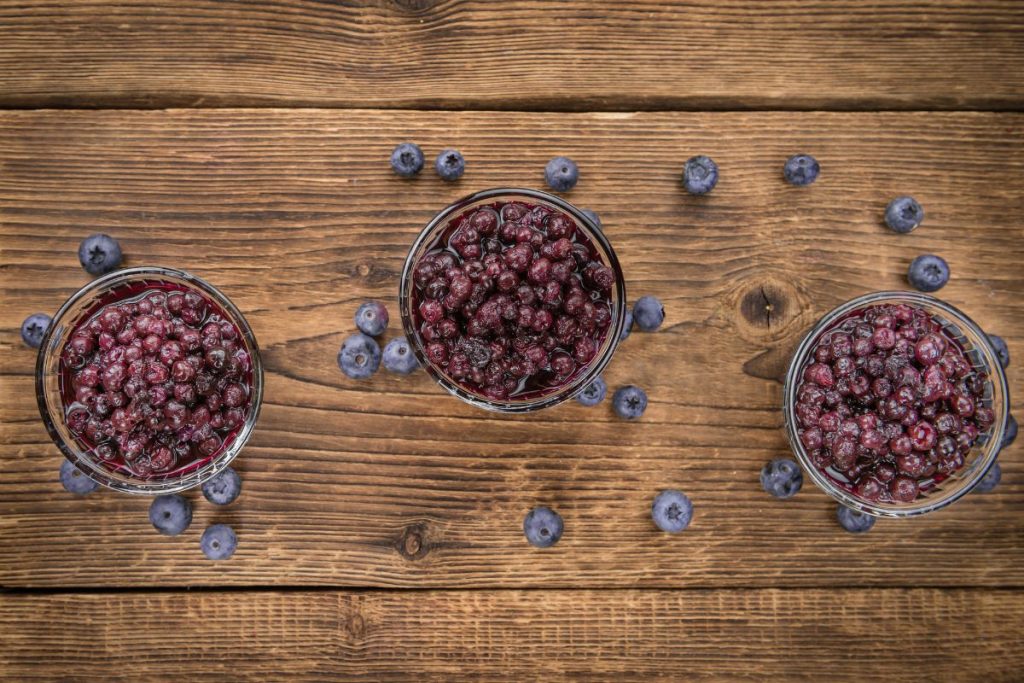
Is Pectin Required for Canning Blueberries?
Plain blueberries don’t require pectin when canning. Pectin is a natural commercially-produced starch essential for giving jams and jellies a thick consistency.
Blueberries have an average level of natural pectin, so the blueberry jam can still gel without adding pectin. However, some recipes require the addition of liquid or powdered pectin to act as glue, which is essential for making a thicker blueberry jam faster.
What are the Benefits of Canning Blueberries?
- Convenience. Jars of blueberries are a quick and convenient option for a quick breakfast or portable snack.
- Health benefits. According to Harvard University, blueberries contain carbohydrates, potassium, fiber, vitamin C, and magnesium essential for gut and heart health.
- Longer shelf life. Canned blueberries have an extended shelf life of up to 12-18 months.
- Saves freezer space. You can easily store processed jars in your pantry, leaving freezer space for other items.
- Saves money. Home-canning blueberries prevents higher grocery costs when they are out of season.
- Versatility. Home-canned blueberries taste great in many recipes, including blueberry pie filling, muffins, waffles, blueberry lemon bread, ice cream, and fresh smoothies.
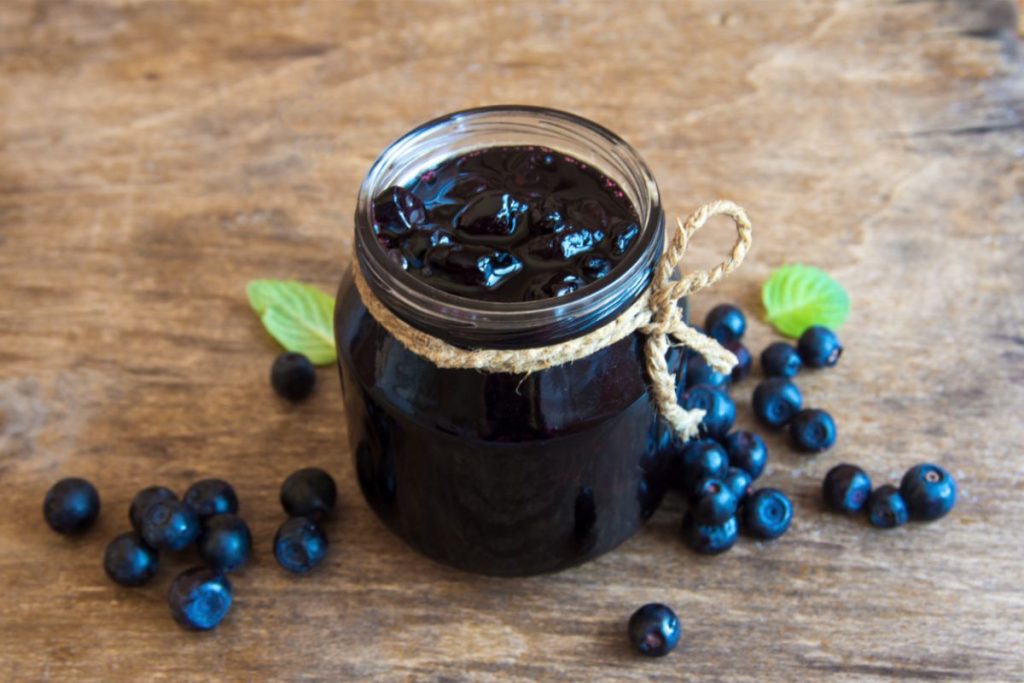
How to Store Canned Blueberries and Blueberry Jam
Some practical storage tips for a longer shelf life include:
- Avoid storage areas with direct sunlight.
- Keep your jars dry and moisture-free to prevent corrosion of metallic lids.
- Maintain cleanliness in the storage area to prevent cross-contamination of food.
- Store sealed jars between 50°F – 70°F and away from heat sources.
The Shelf Life of Canned Blueberries
The best used-by date for home-canned blueberries is one year from the canning date. While you can still safely enjoy your food after the recommended shelf life, the quality may deteriorate over time. According to the USDA, opened jars of high-acid foods such as fruits should be refrigerated and used within 5-7 days.

